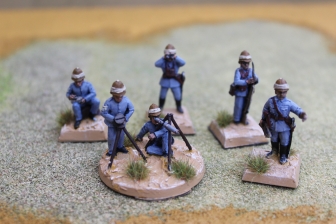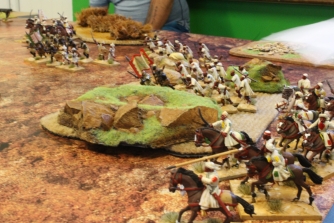Defending the Heliograph
A British signal post (heliograph) has been set up on some high ground to observe any enemy movements and report them back to the main force, somewhere in the distance (off table).
Mahdist forces had been spotted moving towards the position but the British seem unwilling to withdraw. Perhaps they have a patrol rushing to their aid?
The Mahdists would win by destroying the heliograph. The British by successfully defending the hilltop and keeping the heliograph in position. A partial victory could be had by moving the heliograph team to safety.
The British started with a the heliograph on the hill, defended by a unit of Highlanders. There were two groups of Mahdists that appeared at random locations on the table edges. They were put on table and the Highlanders could then position themselves within a move of the hilltop. The British then rolled for their own entry points but had to be two moves from any enemy already deployed. The set up resulted in the Mahdists having an attack force of two tribal cavalry units, two tribal infantry units and a rifle armed irregular unit in the south east corner. Their support force arrived on the northern edge consisting of two tribal infantry units, a rifle armed irregular unit, a rifle armed unit of Sudanese deserters from the Egyptian army and a Krupp gun. The British patrol appeared on the western edge comprising of three regular infantry units, a unit of Bengal lancers and a Gatling gun.


Most of the Mahdists to the north advanced towards the British reinforcements whilst their gun and rifle units tried to close on the hill. Their movement was very slow and lacked enthusiasm. The other Mahdists moved more swiftly targeting the Highlanders. One unit of cavalry and one of tribal infantry tried to move west and outflank the Highland line whilst the other units attacked head on.
The Bengal Lancers raced to support the Highlanders who themselves were inflicting heavy casualties on any Mahdists attacking to their front; throwing back attacks by tribal infantry and cavalry. Their numbers were being whittled down but they held on before pulling back onto the hill. Here they successfully repulsed attacks on the heliograph unit itself by the remnants of the Mahdist cavalry which had recovered from its initial mauling although its supporting infantry had routed away. The Bengal Lancers had saved the Highlanders as they arrived just in time to attack first the outflanking tribal cavalry and then the infantry behind. But this had come with a heavy cost and the lancers were themselves wiped out.
Meanwhile the Gatling gun and the most northerly British infantry unit had easily dispensed with the nearest tribal infantry and advanced east. As they did so they were met by the Mahdist artillery, a unit of irregular riflemen and the deserters. This resulted in the Gatling gun crew being wiped out along with a British infantry unit. The Mahdist riflemen were forced to flee the battlefield but the deserters were able to now bring long range fire on the hilltop supported by the Krupp gun. It was at this point that the British chose to withdraw what remained of the heliograph crew and the last two gallant Highlanders.
The battle was a close run thing but the British were able to withdraw as they still had two infantry units intact and most of the Mahdist melee units had been destroyed or were very reduced. A partial victory for the British after a hrd fought encounter.





